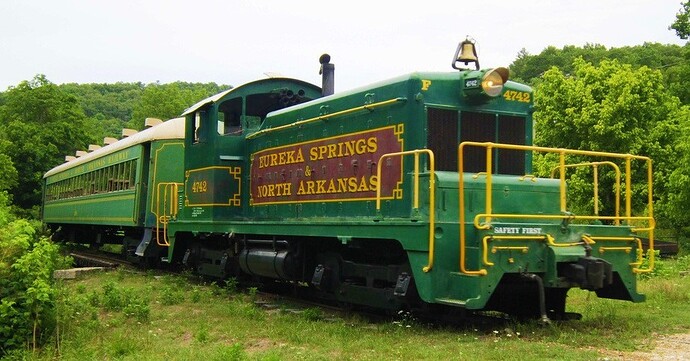Interesting signal bridge - one B&O CPL and a semaphore in one direction and double semaphores in the other direction.
Yeah, what does that indicate? I don’t know anything about semaphores.
Rich
Not knowing the speed of the train - I suspect the semaphore that is at a 45 degree angle is in the process of dropping from Clear that was displayed for the train to Stop that will be displayed behind the train. Clear being vertical and Stop being horizontal.
All signal systems of the era would take some time to change the signals they displayed account working through the logic of a series of electrical relays.
Ahh, thanks for that info. I should study up on semaphores.
Rich
That is interesting. Thanks for posting.
Rich
I can’t say for certain that it was universal but the style of the blade end played a role in determining what type of signal it was. 1) Pointed end blades were used as intermediate signals on automatic block systems . 2) Square end blades were used as absolute signals on interlocking plants. 3) Fishtail blades were used on distant signals. 4) Round end blades were used on train order boards at stations or interlocking towers, etc.
Many more variants to cover but that is a general rule.
Regards, Ed
Thanks, Ed. That sure seems like it could be confusing. It would really take some getting used to. I am mainly referring to all those different blade shapes and their purpose.
Rich
Note in the picture there are two types of blades shown - Pointed and Square, both on the same signal bridge.
Thanks, I had not noticed that.
Rich
The pointed ends on a semaphore meant permissive. That’s why they were on the intermediate signals. Some railroads used a square end on their train order signals, too. It’s also era dependent. In later years, some rulebooks had a note saying blade type, or signal head location on the mast did not matter.
I would guess in the picture, one direction was the home signal for the interlocking. The other was governing trains leaving the interlocking plant.
Jeff
![]()
I wonder if there is a CPL on a mast behind the locomotive, to go with the mast-mounted semaphore I see.
When were the CPLs installed here? It seems to me more likely there would be one ‘outbound’ than ‘inbound’…
Not very many places where the C&EI/C&WI and the B&OCT came close or crossed. Dolton tower?
So it seems.
Don’t overlook that B&O CPL’s were installed on the Alton during its years of B&O ownership.
In that case it would have to be just west of the spot where the C&WI ducked under the Rock Island. C&WI’s 15th Street yard behind the train. The Alton/GM&O yard east lead on left of the train will join the C&WI behind the photographer. Single eastbound semaphores are distant signals for junction of AT&SF coach yard lead and Dearborn station throat.
I’m amazed that the photo that I posted has generated this much interest. I’m going to pull out my CD slide show to see if y’all are correctly placing that signal bridge.
Rich
Part of the C&EI still lives. Ex C&EI, ex MP EMD SW1 found working on the Eureka Springs and North Arkansas Railroad dinner train. Trying to upload photos but having diff.
Front of the engine has been modified to eliminate the foot boards that existed with the SW-1’s when they were built. Suspect the rear was also modified.
